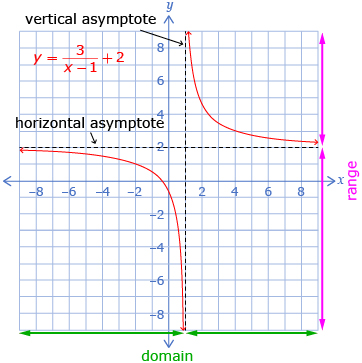In Try This 2 you may have noticed that the rules of transformations apply to rational functions the same way they apply to the other functions you have worked with in this course. As an example, you explored a rational function of the form ![]() because it allows you to work with transformations relatively easily. Some characteristics of the graph of a function of the form
because it allows you to work with transformations relatively easily. Some characteristics of the graph of a function of the form ![]() are listed in the chart shown.
are listed in the chart shown.
Rational Functions of the Form |
|
| Vertical Stretch | There is a vertical stretch by a factor of a. |
| Horizontal Asymptote | The horizontal asymptote is translated k units up or down from the original location of y = 0. The horizontal asymptote is y = k. |
| Vertical Asymptote | The vertical asymptote is translated h units right or left from the original location of x = 0. The vertical asymptote is x = h. |
| Domain | The domain is any real number, except h. This restriction is because x = h (the vertical asymptote) will result in an undefined value. |
| Range | The range is any real number, except k. This restriction is because the horizontal asymptote is y = k. |
An example of a graph of a rational function ![]() follows.
follows.
